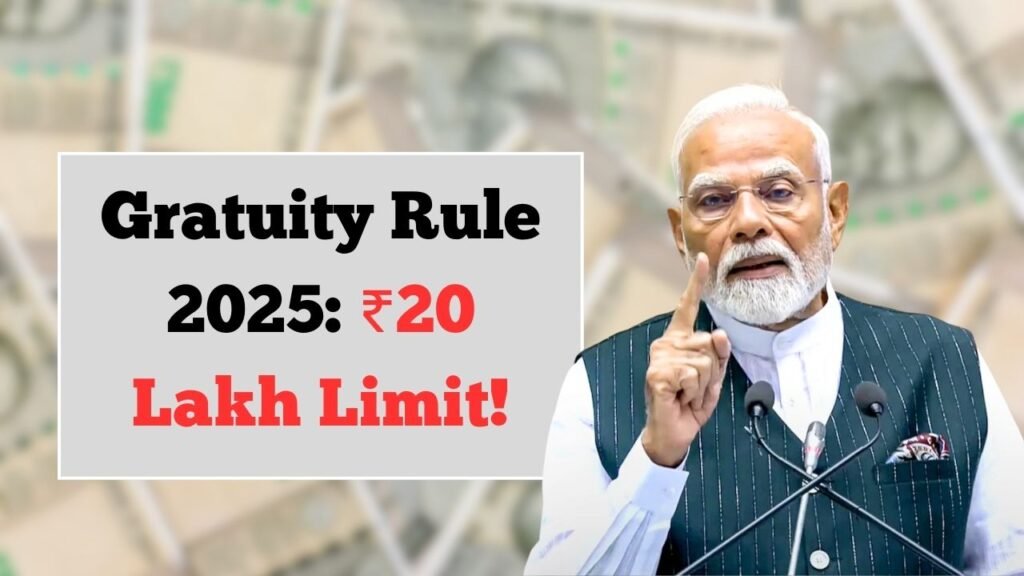Gratuity Rule : When people think about retirement benefits, gratuity is one of the first things that comes to mind. It is not just money, but also a way for the company to thank an employee for their loyalty and service. Under the Payment of Gratuity Act, 1972, gratuity is given to employees who work at least five years with the same employer. For many workers, gratuity becomes an important part of their retirement plan or even useful during a career change. Let’s understand gratuity rules in 2025, how it is calculated, and what the ₹20 lakh maximum limit means.
How Gratuity is Calculated
The formula to calculate gratuity is simple once you know it. It is based on your last drawn basic salary, dearness allowance, and total years of service.
Formula:
Gratuity = (Basic Salary + Dearness Allowance) × 15/26 × Years of Service
Here, “15” means 15 days’ salary for every completed year of work. “26” is taken as the number of working days in a month, leaving out weekly offs. So, in short, gratuity is half a month’s salary for every year you work.
Example of Gratuity Calculation
Let’s understand with an example.
- Last basic salary + DA = ₹50,000
- Years of service = 10 years
Step 1: ₹50,000 × (15/26) = ₹28,846
Step 2: ₹28,846 × 10 = ₹2,88,460
So, the gratuity is about ₹2.88 lakh.
If the salary was ₹55,000 with the same 10 years, the gratuity becomes about ₹3.17 lakh. This shows that higher salary and more years of service always increase gratuity.
Gratuity Example Table
| Last Drawn Salary (Basic + DA) | Years of Service | Gratuity Amount |
| ₹50,000 | 10 years | ₹2.88 lakh |
| ₹55,000 | 10 years | ₹3.17 lakh |
| ₹60,000 | 12 years | ₹4.15 lakh |
The Maximum Limit of ₹20 Lakh
According to current rules, the maximum gratuity that an employee can get is ₹20,00,000. Even if your salary is very high or you work for many years, you cannot receive more than this amount. This cap is the same for everyone, which keeps the system fair for both employees and employers.
Who Can Get Gratuity
Not all employees get gratuity automatically. To become eligible, an employee must complete at least five years of continuous service with the same employer. In some cases, even contract workers may be eligible if company rules allow.
Gratuity is paid when an employee retires, resigns, or is terminated (under certain conditions). It is also given to employees who cannot work due to illness or disability.
Why Gratuity is Important
Gratuity is more than just a rule. It is a safety net for employees. After years of work, employees know they will get a lump sum to help them in retirement.
This money can be used for many things—repaying loans, children’s education, or investments for future income. For employers, it is a way of rewarding loyalty and long service.
Gratuity in 2025
With living costs rising every year, gratuity is still very important for financial planning. While the ₹20 lakh cap may feel small for some high earners, for most workers, it is a big help.
Employees should remember gratuity when planning job changes. If you switch jobs too often before completing five years, you may lose this benefit.
Final Thoughts
Gratuity may not look very important when you are young, but over time it becomes a valuable benefit. Knowing how it works, who gets it, and what the limits are will help you plan better. Whether you are retiring soon or thinking of changing jobs, understanding gratuity rules in 2025 is very important.
Disclaimer: The information in this article is intended for general educational purposes only. Gratuity rules may differ according to company policies, employment contracts, and government updates. Readers should double-check details with official notifications or consult a financial advisor before making any decisions based on this information.




